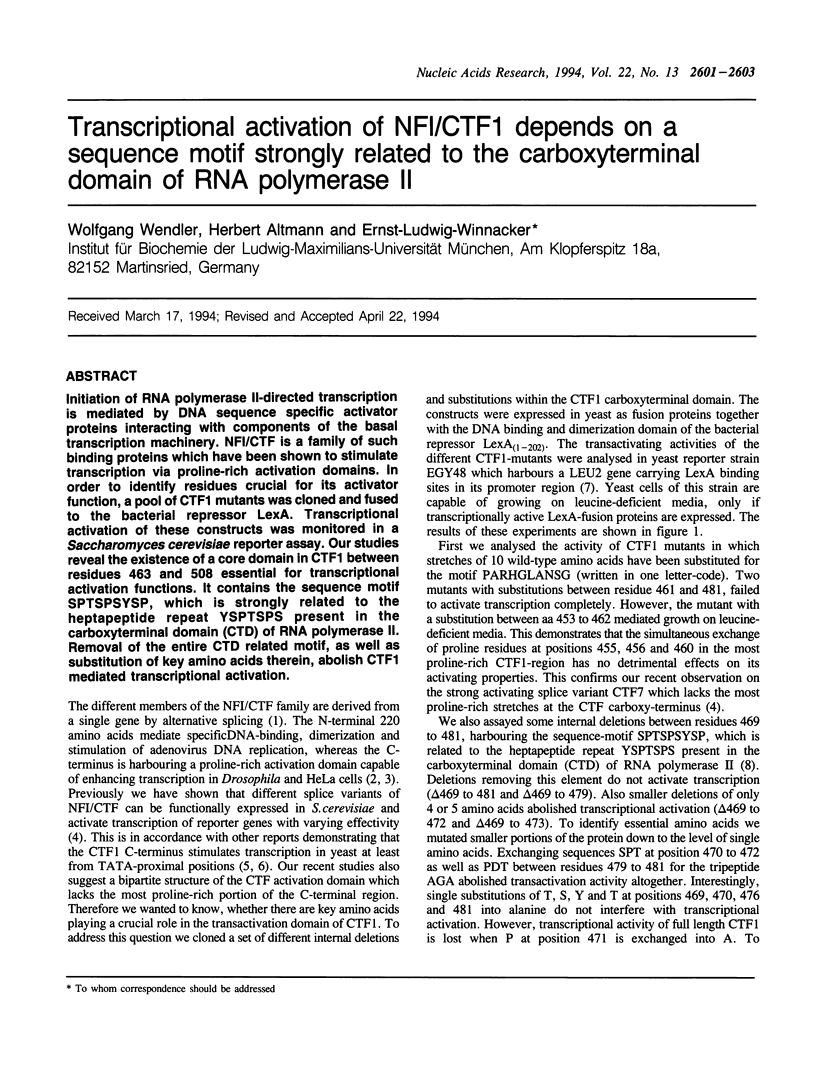Transcriptional activation of NFI/CTF1 depends on a sequence motif strongly related to the carboxyterminal domain of RNA polymerase II (original) (raw)
Abstract
Initiation of RNA polymerase II-directed transcription is mediated by DNA sequence specific activator proteins interacting with components of the basal transcription machinery. NFI/CTF is a family of such binding proteins which have been shown to stimulate transcription via proline-rich activation domains. In order to identify residues crucial for its activator function, a pool of CTF1 mutants was cloned and fused to the bacterial repressor LexA. Transcriptional activation of these constructs was monitored in a Saccharomyces cerevisiae reporter assay. Our studies reveal the existence of a core domain in CTF1 between residues 463 and 508 essential for transcriptional activation functions. It contains the sequence motif SPTSPSYSP, which is strongly related to the heptapeptide repeat YSPTSPS present in the carboxyterminal domain (CTD) of RNA polymerase II. Removal of the entire CTD related motif, as well as substitution of key amino acids therein, abolish CTF1 mediated transcriptional activation.

Selected References
These references are in PubMed. This may not be the complete list of references from this article.
- Altmann H., Wendler W., Winnacker E. L. Transcriptional activation by CTF proteins is mediated by a bipartite low-proline domain. Proc Natl Acad Sci U S A. 1994 Apr 26;91(9):3901–3905. doi: 10.1073/pnas.91.9.3901. [DOI] [PMC free article] [PubMed] [Google Scholar]
- Drapkin R., Merino A., Reinberg D. Regulation of RNA polymerase II transcription. Curr Opin Cell Biol. 1993 Jun;5(3):469–476. doi: 10.1016/0955-0674(93)90013-g. [DOI] [PubMed] [Google Scholar]
- Gyuris J., Golemis E., Chertkov H., Brent R. Cdi1, a human G1 and S phase protein phosphatase that associates with Cdk2. Cell. 1993 Nov 19;75(4):791–803. doi: 10.1016/0092-8674(93)90498-f. [DOI] [PubMed] [Google Scholar]
- Kim T. K., Roeder R. G. CTD-like sequences are important for transcriptional activation by the proline-rich activation domain of CTF1. Nucleic Acids Res. 1994 Jan 25;22(2):251–251. doi: 10.1093/nar/22.2.251. [DOI] [PMC free article] [PubMed] [Google Scholar]
- Kim T. K., Roeder R. G. Transcriptional activation in yeast by the proline-rich activation domain of human CTF1. J Biol Chem. 1993 Oct 5;268(28):20866–20869. [PubMed] [Google Scholar]
- Knox J. J., Rebstein P. J., Manoukian A., Gronostajski R. M. In vivo stimulation of a chimeric promoter by binding sites for nuclear factor I. Mol Cell Biol. 1991 Jun;11(6):2946–2951. doi: 10.1128/mcb.11.6.2946. [DOI] [PMC free article] [PubMed] [Google Scholar]
- Künzler M., Braus G. H., Georgiev O., Seipel K., Schaffner W. Functional differences between mammalian transcription activation domains at the yeast GAL1 promoter. EMBO J. 1994 Feb 1;13(3):641–645. doi: 10.1002/j.1460-2075.1994.tb06302.x. [DOI] [PMC free article] [PubMed] [Google Scholar]
- Lech K., Anderson K., Brent R. DNA-bound Fos proteins activate transcription in yeast. Cell. 1988 Jan 29;52(2):179–184. doi: 10.1016/0092-8674(88)90506-5. [DOI] [PubMed] [Google Scholar]
- Meisterernst M., Rogge L., Foeckler R., Karaghiosoff M., Winnacker E. L. Structural and functional organization of a porcine gene coding for nuclear factor I. Biochemistry. 1989 Oct 3;28(20):8191–8200. doi: 10.1021/bi00446a034. [DOI] [PubMed] [Google Scholar]
- Mermod N., O'Neill E. A., Kelly T. J., Tjian R. The proline-rich transcriptional activator of CTF/NF-I is distinct from the replication and DNA binding domain. Cell. 1989 Aug 25;58(4):741–753. doi: 10.1016/0092-8674(89)90108-6. [DOI] [PubMed] [Google Scholar]
- Peterson S. R., Dvir A., Anderson C. W., Dynan W. S. DNA binding provides a signal for phosphorylation of the RNA polymerase II heptapeptide repeats. Genes Dev. 1992 Mar;6(3):426–438. doi: 10.1101/gad.6.3.426. [DOI] [PubMed] [Google Scholar]
- Seipel K., Georgiev O., Gerber H. P., Schaffner W. C-terminal domain (CTD) of RNA-polymerase II and N-terminal segment of the human TATA binding protein (TBP) can mediate remote and proximal transcriptional activation, respectively. Nucleic Acids Res. 1993 Dec 11;21(24):5609–5615. doi: 10.1093/nar/21.24.5609. [DOI] [PMC free article] [PubMed] [Google Scholar]
- Suzuki M. SPXX, a frequent sequence motif in gene regulatory proteins. J Mol Biol. 1989 May 5;207(1):61–84. doi: 10.1016/0022-2836(89)90441-5. [DOI] [PubMed] [Google Scholar]